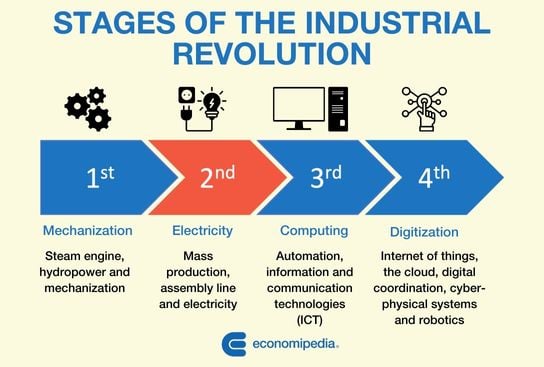Second Industrial Revolution
Since 1850, the phenomenon known as the Second Industrial Revolution took place in some countries, especially in Europe. Many historians place the end of this process in 1914, coinciding with the outbreak of the World War I.
This phenomenon can be considered the second phase of the First Industrial Revolution that took place in the United Kingdom. In this case, the countries in which industrial advances expanded were France, Germany, Belgium, Japan and the United States. Subsequently, industrialization would spread to Spain, Russia and Italy and later to the rest of the Western countries. Decades later, we experienced a third and even a fourth industrial revolution.
The Second Industrial Revolution meant that technological and scientific advances spread from the United Kingdom to other places. Obviously, the expansion of these elements also had repercussions in these countries. The Second Industrial Revolution also marked the beginning of economic globalization.
The use of new materials was a key element in the Second Industrial Revolution.
At this time, technological and scientific advances began to take on a more complex nature. As a result, access was gained to different natural resources that had been unavailable or of little use up to that time. Among them, the use of metals such as steel, zinc, aluminum, nickel or copper, among others, stands out.
In addition, chemical products are beginning to be taken into account, thanks to the advancement of this industry. Products such as soda, artificial dyes, explosive materials or fertilizers became increasingly used.
At the same time, new forms of energy began to appear. Technological advances made it possible to achieve an increase in available energy, which also diversified. This phenomenon was possible, first of all, due to the improvement of those techniques that were already known. In this sense, we can speak about Watt’s machine, turbines or the gas industry. Likewise, new ways of obtaining energy, such as electricity or oil, were also developed.
The railroad: a new mode of transport
One of the most important effects of the Second Industrial Revolution can be found in transportation. During this new era, the world of transportation was modernized, shortening distances and reducing costs.
This meant the possibility of connecting markets that previously had any kind of relationship. Therefore, both the transport of people and goods was facilitated, bringing countries, peoples and cultures closer together.
The railroad was the means of transport that symbolized this new era. An era based on faith in technology and the possibility of overcoming all limits. A fact that demonstrates this importance. In 1840 there were less than 4,000 kilometers of track; in 1870, in Europe there were more than 100,000 kilometers and in the United States 70,000.
The Second Industrial Revolution facilitated the emergence of new powers.
From the perspective of international relations, the Second Industrial Revolution consolidated new world powers. Germany, the United States and Japan became major international players. The success of these new powers could be observed in different aspects.
Germany showed its power in the Franco-Prussian War, in which it prevailed over France. The United States boosted its westward expansion by seeking new lands to colonize. Japan, with the Meiji Restoration, which led to the modernization of the country, came out of its traditional one.
In parallel, a new form of capitalism was consolidated, which tended towards a monopolistic character. On the other hand, the need to seek new markets led to an acceleration of imperialist projects.
This new situation, in which the industrial powers rivaled to conquer new territories and expand their markets, led to episodes of frank tension and even war. The culmination of this situation was ultimately the outbreak of the World War I.
In short, we can say that the Second Industrial Revolution meant the expansion of the first one. The advances made by the United Kingdom were generalized and improved. Finally, this new situation had the effect of reshaping capitalism and the international order, which gave rise to a period of tension between the different industrial powers in their attempt to expand their markets.


